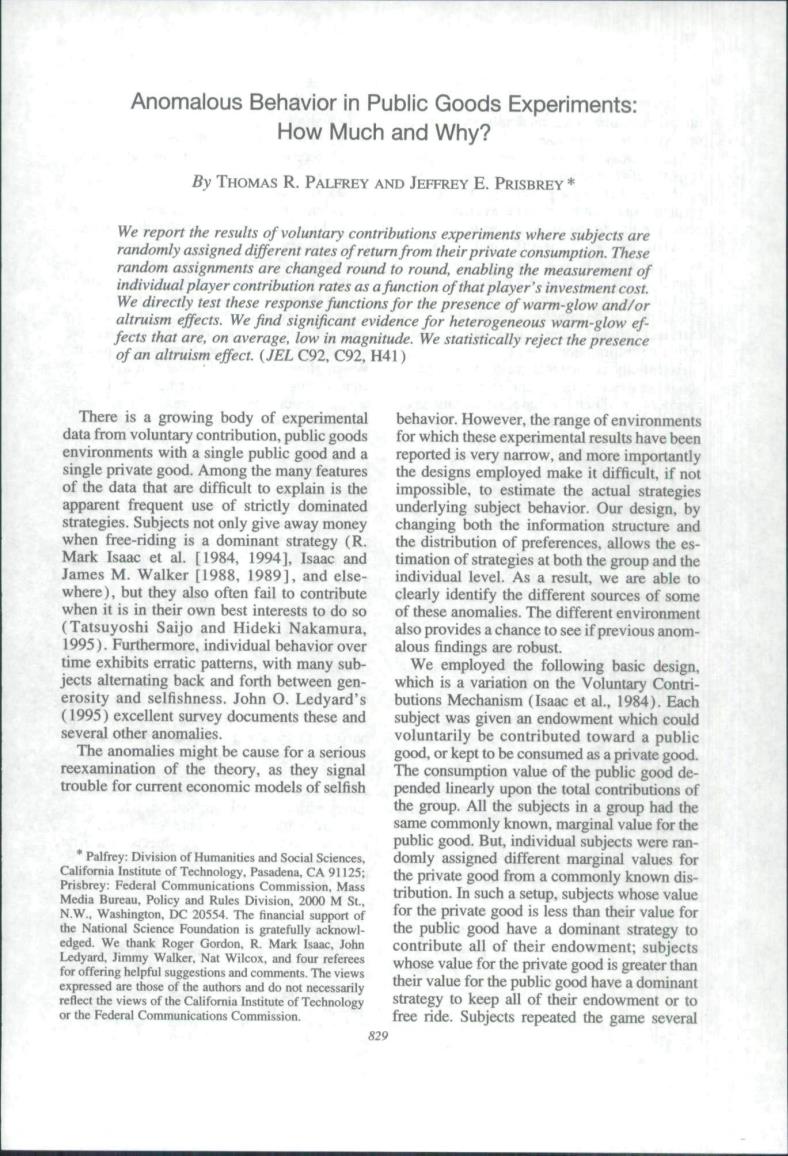正在加载图片...

Anomalous Behavior in Public Goods Experiments: How Much and Why? By THOMAS R.PALFREY AND JEFFREY E.PRISBREY* random assignments are changed round to round enabli mption.Thes for the presence of warm-glow and/o fects that are.on av dcncehc m-glow ef of an altruism effect.(JEL C92.C92.H41) ct the presenc for which th er,the range of environments reported is very nan row and more in he designs employed make it difficult,if no to estimate the actual strategies han both the info the distribution of preferences,allows the James M.Walker [I9 d the wherebut they also o fa t own best int terests to do so Nakamura ime exhibits er atic na jects alternating back and forth betwe butions Mechanism (Isaac et al..1984).Each nt survey documents these and The anomalies might be cause for a se contributed toward a publi the group.All th subjects in group had the oublic 91125 the private good from a commonly known dis onnsuch a setup.subject whose valu 54.The fnan the and The vie log for the good have a domina 829 Anomalous Behavior in Public Goods Experiments: How Much and Why? By THOMAS R. PALFREY AND JEFFREY E. PRISBREY * We report the results of voluntary contributions experiments where subjects are randomly assigned different rates of return from their private consumption. These random assignments are changed round to round, enabling the measurement of individual player contribution rates as a function of that player's investment cost. We directly test these response functions for the presence of warm-glow and/or altruism effects. We find significant evidence for heterogeneous warm-glow effects that are. on average, low in magnitude. We statistically reject the presence of an altruism effect. (JEL C92, C92, H4I) There is a growing body of experimental data from voluntary contribution, public goods environments with a single public good and a single private good. Among tbe many features of tbe data tbat are difficult to explain is tbe apparent frequent use of strictly dominated strategies. Subjects not only give away money wben free-riding is a dominant strategy (R. Mark Isaac et al. [1984, 1994], Isaac and James M. Walker [1988, 1989], and elsewbere), but tbey also often fail to contribute wben it is in their own best interests to do so (Tatsuyoshi Saijo and Hideki Nakamura, 1995). Furtbermore, individual bebaviorover time exbibits erratic patterns, witb many subjects alternating back and fortb between generosity and selfisbness. John O. Ledyard's (1995) excellent survey documents tbese and several otber anomalies. Tbe anomalies might be cause for a serious reexamination of tbe tbeory, as they signal trouble for current economic models of selfish * Palfrey: Division of Humanities and Social Sciences, California Institute of Technology, Pasadena, CA 91125; Prisbrey: Federal Communications Commission, Mass Media Bureau. Policy and Rules Division, 2000 M St.. N.W., Washington, DC 20554, The financial support of the National Science Foundation is gratefully acknowledged. We tbank Roger Gordon, R. Mark Isaac, John Ledyard. Jimmy Walker. Nat Wilcox, and four referees for offering helpful suggestions and comments. The views expressed are those of the authors and do not necessarily reflect the views of the California Institute of Technology or the Federal Communications Commission. bebavior. However, tbe range of environments for which tbese experimental results bave been reported is very narrow, and more importantly tbe designs employed make it difficult, if not impossible, to estimate tbe actual strategies underlying subject behavior. Our design, by changing both tbe information structure and the distribution of preferences, allows the estimation of strategies at botb tbe group and the individual level. As a result, we are able to clearly identify the different sources of some of tbese anomalies. Tbe different environment also provides a chance to see if previous anomalous findings are robust. We employed the following basic design, which is a variation on tbe Voluntary Contributions Mechanism (Isaac et al., 1984). Eacb subject was given an endowment whicb could voluntarily be contributed toward a public good, or kept to be consumed as a private good. Tbe consumption value of the public good depended linearly upon tbe total contributions of tbe group. All the subjects in a group bad the same commonly known, marginal value for tbe public good. But. individual subjects were randomly assigned different marginal values for the private good from a commonly known distribution. In sucb a setup, subjects wbose value for tbe private good is less than their value for tbe public good have a dominant strategy to contribute all of tbeir endowment; subjects wbose value for tbe private good is greater than their value for the public good bave a dominant strategy to keep all of tbeir endowment or to free ride. Subjects repeated tbe game several 829